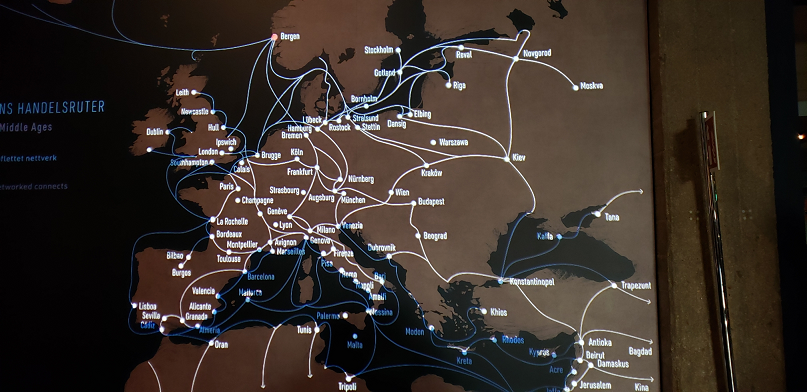Last Updated on May 31, 2022

Hanseatic League Trade Routes
There we were in the vibrant city of Bergen, Norway, one of the big players in the old Hanseatic League. You could think of the Hanseatic League as a forerunner of today’s EU plus NATO. A wonderful lecture about the Hanseatic League was offered in the ship’s theater, and I found it so fascinating that I later watched a video of it on the TV in our stateroom. I recalled first hearing about the Hanseatic League decades ago in high school history class, but I was more interested in my boyfriend Joe at the time and was therefore not paying much attention. BTW, “hansa” is a German word meaning company or association or guild.
Between the 14th and the 17th centuries (or 1300’s to 1600’s, if you prefer), the Hanseatic League was a powerful association of more than 100 different cities or ports that traded with each other according to agreed-upon rules and regulations. For example, think contracts and maps, cargo lists and scales, stamps, seals, and the indispensable business letter. Think apprentices and journeymen and warehouses. Their seafaring trade routes covered more than 1,000 miles. In those days, the Bubonic Plague was killing millions of people in Europe, so it was actually a better and safer idea for merchants to leave the congested, infested cities and travel by water to do business.
The Hanseatic League gave its members mutual protection from ferocious pirates who were always lurking just around the corner…or over the horizon. Keep in mind that pirates did not take prisoners. If you think about it, where would they even put prisoners on the high seas? How would they feed prisoners? So the pirates just threw all their victims overboard. Membership in the Hanseatic League definitely provided benefits.
This topic of pirates segues nicely into a few words about the “Baltic Cog” which was a vessel specially built for Hanseatic League commerce. The Baltic Cog was designed to carry lots of cargo. It was not designed for speed (only 5 knots). However, it was good for fighting pirates because it was a relatively tall vessel which enabled the crew to shoot their arrows and throw their spears downward at their enemies. Each city flew its own flag on its Baltic Cog as well as the Hanseatic League flag for recognition and protection. Even lighthouses were built during this time.
Every regional member of the Hanseatic League had its own specialty products, and I love to think about these products. From Norway, codfish and whale oil. From Sweden, copper, iron ore and herring. From Russia, furs and timber. From Denmark, cheese. From England, wool. From Italy, wine. From Prussia, grain. From Poland, tar, honey and flax. From the Middle East, dates and figs. From Flanders, flax and linen. To preserve their codfish, the people of Norway at first sun-dried it; later on, they salted it. Preserved codfish could last 5 to 10 years! It was a great source of protein for Europeans, and since most people at the time were Catholic and were required to eat fish on Fridays and other holy days, there was a huge market for codfish.
Well, as they say, all good things come to an end, and so did the Hanseatic League. Why? First, the small city-states were expanding. Nation-building had started throughout Europe with centralized governments and organized militaries wielding the power. Second, countries like Spain and Portugal were building boats that could travel farther which enabled new world exploration which, in turn, produced big wealth in gold and silver as well as sugar and slavery. And third, the Protestant Reformation reduced Europe’s Catholic population which led to decreased demand for codfish.
If I had been assuming that we in the 21st Century are different from the people of the late Middle Ages, I was reminded by this lecture of the unchanging nature of human impulses and tendencies and desires. We are an enterprising species – curious, striving, ambitious, innovative. We are also vulnerable. And perhaps also greedy and power-hungry.
Regarding my high school boyfriend Joe…I have absolutely no regrets about daydreaming through history class. I probably was not mature enough to understand the Hanseatic League anyway.
Julie Helms
